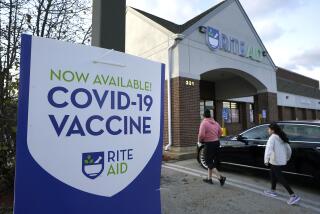U.S. to Offer Medicare PPO Program
WASHINGTON — Top federal health officials Tuesday announced a new Medicare pilot program that will give about 11 million senior citizens--nearly a third of current enrollees--the option of choosing a preferred provider organization, or PPO, for their medical care next year.
The plan is being offered in 23 states by 33 private insurance companies. In California, seniors in Los Angeles and Orange counties will have the option of choosing PacifiCare (New Horizons) as their provider during the upcoming open enrollment period that starts on Nov. 15.
In unveiling the plan, Health and Human Services Director Tommy G. Thompson said he “abhorred the status quo,” and that the new plan offers seniors what they have been asking for: more choices for health care and prescription drug coverage, although limited.
He pointed out that more Americans under the age of 65 choose PPOs than any other health insurance option. PPOs offer a loose network of physicians and allow enrollees to pay an additional fee to see other physicians. The premiums for PPOs generally are higher than for HMOs but less than fee-for-service policies.
The program, while embraced by several leading senior citizen organizations, was criticized by some advocacy groups as an attempt to sidestep the controversial prescription drug benefit debate with stopgap privatized coverage.
“There is simply no substitute for providing a prescription drug benefit for seniors,” said Gail Shearer, director of health policy analysis for Consumers Union. “This plan dances around it. It provides enriched benefits for some but leaves many with nothing.”
Until now, the closest seniors could come to a PPO was the managed care-based program called Medicare Plus Choice, or they could purchase so-called Medigap policies such as Medicare SELECT, designed to bridge gaps in standard coverage by offering beneficiaries lower premiums or increased benefits if they use the plan’s network of providers.
Those programs, however, have struggled in much of the country since being introduced in the mid-1990s, leading critics to cite those problems as a stark example of the limits of privatization.
While initially popular with eligible seniors--particularly those in low-income and minority communities--Medicare Plus Choice quickly faltered as enrollees saw promised benefits curtailed and providers dropped out complaining of scaled-back reimbursements.
“I think seniors were understandably nervous about a plan when you have a limited number of choices,” said Tom Scully, administrator of the Centers for Medicare and Medicaid Services.
At a minimum, Scully said, Medicare officials expect 150,000 to 200,000 seniors to choose a Medicare PPO option. “I think it will be a lot more,” he added.
To entice insurers to participate, the federal government offered to share the financial risks.
Under the financial arrangement, private insurers will be reimbursed either at 99% of the fee-for-service rate for standard Medicare coverage or at the local going rate for the Medicare Plus Choice program, which varies throughout the country.
The private insurer must offer all the coverage available through the traditional fee-for-service Medicare plan but then may elect to provide additional options to enrollees.
All 33 plans announced Tuesday, for example, offer some form of prescription drug benefit, although officials noted it is far less comprehensive than such plans available to most insured Americans under 65. The insurer then bears both the risk and the potential benefits of any costs that go either 2% over or 2% under actual expenses.
Beyond that margin, insurers have the option of either sharing additional risks or profits at preestablished percentages or going it alone.
Scully said that the arrangement allowed PPOs, which were eligible to participate in Medicare Plus Choice but did not, to feel comfortable venturing into the senior health-care market.
Although the demonstration project is for three years, the contracts with providers are yearly, meaning they could drop out sooner.
Top health officials concede that the history so far with Medicare Plus Choice may make it tougher for the PPOs to market their plans to seniors. Thompson and Scully said they announced the new program Tuesday in part to allow the insurers ample time to make their case to seniors before the fall open enrollment period. But some critics argue that seniors are right to be wary.
Amanda McCloskey, director of health policy for Families USA, an advocacy group pushing for health-care system reforms, said she is troubled that because the plans are labeled as “Medicare,” seniors will have the false impression that the benefits are guaranteed.
“I think folks have to be pretty confused at this point. They get used to certain doctors and benefits and then the rug has been pulled out from under them,” she said. “But why would we expect anything different than what we have seen every year--insurance companies asking for more money and then cutting back on the benefits they offer.”
More to Read
Inside the business of entertainment
The Wide Shot brings you news, analysis and insights on everything from streaming wars to production — and what it all means for the future.
You may occasionally receive promotional content from the Los Angeles Times.











